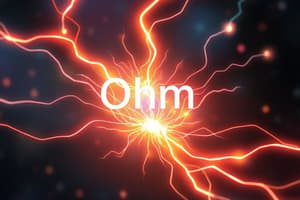Podcast
Questions and Answers
What is an Ohm?
What is an Ohm?
The Ohm is the unit of measure for electrical resistance.
What is Ohm's Law?
What is Ohm's Law?
Ohm's Law describes the mathematical relationship between voltage, amperage, and resistance.
_________ is a mathematical equation that describes the relationship between voltage, amperage, and resistance. If anyone of the three is changed, it affects the others.
_________ is a mathematical equation that describes the relationship between voltage, amperage, and resistance. If anyone of the three is changed, it affects the others.
Ohm's Law
_______ is the work that is performed when voltage and amperage are combined. It is the measurement of power. Voltage by itself cannot perform any work, and amps cannot flow without voltage. When a number of amps flow at a given voltage, the result is _______.
_______ is the work that is performed when voltage and amperage are combined. It is the measurement of power. Voltage by itself cannot perform any work, and amps cannot flow without voltage. When a number of amps flow at a given voltage, the result is _______.
What is a Watt?
What is a Watt?
How many watts equal one horsepower?
How many watts equal one horsepower?
What are the effects that resistance and power have on the electrical system?
What are the effects that resistance and power have on the electrical system?
Flashcards are hidden until you start studying
Study Notes
Electrical Resistance and Ohm's Law
- The Ohm is the unit measuring electrical resistance, indicating a conductor's opposition to electron flow.
- Every conductor exhibits some level of resistance, quantified in Ohms.
- Sufficient voltage is necessary to overcome resistance, allowing current to flow.
- Ohm's Law describes the relationship among voltage, amperage, and resistance.
- States that one volt can push one amp through one ohm of resistance.
- Changes in voltage, amperage, or resistance will impact the others due to Ohm's Law.
Power and Wattage
- Wattage represents the work done when voltage and amperage are combined, serving as a measure of power.
- Voltage alone cannot perform work, and amperage cannot flow without voltage.
- Wattage is calculated as Watts = Volts x Amps.
- One watt is generated when one amp flows through a one-volt potential difference.
Horsepower and Electrical Power
- One horsepower is equivalent to 746 watts, providing a standard measurement to compare electrical power to mechanical power.
Effects of Resistance
- High resistance in a conductor generates increased friction, producing heat and light as by-products.
- Understanding the implications of resistance on electrical systems is crucial for efficient energy management.
Studying That Suits You
Use AI to generate personalized quizzes and flashcards to suit your learning preferences.




